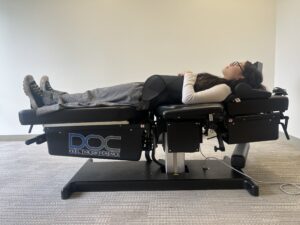The shoulder is a complex structure, build up of three bones and two joints, and quite a few muscles, tendons,
Shoulder pain is very common problem, which usually arises from the shoulder joint itself, or from any of the many surrounding soft tissues (muscles, ligaments or tendons). But various diseases and conditions that are affecting structures in the chest or abdomen, such as heart disease or gallbladder disease, can cause shoulder pain too. This pain unlike the pain that arises directly from the shoulder structures, doesn’t worsen when moving the shoulder.
The pain may be temporary and wears out on itself, or it may continue and require medical diagnosis and treatment.
If you have pain that doesn’t improve after two week, consider visiting medical doctor or chiropractor.
Causes of Shoulder Pain
As with other joint, the problems with shoulder are most likely to get after 60 years, because of the degenerative (wear and tear) changes in the joint. Every condition that affects the joint itself or the surrounding soft tissues causes pain.
Most common causes include:
- Injuries such as dislocated shoulder, muscle and ligament strains, fractures of the joint or bones forming the joint (collarbone, upper arm bone
and shoulder blade), separated shoulder, rotator cuff injury, tendon rupture, torn cartilage, brachial plexus injury, etc. - Inflammation of the tendons (tendinitis and bursitis) that can be acute and chronic.
- Rheumatoid conditions such as rheumatoid arthritis, osteoarthritis, polymyalgia rheumatic, systematic lupus erythematous, septic arthritis, etc.
- Overuse
- Impingement syndrome
- Frozen shoulder– Also called adhesive capsulitis, is a painful and disabling condition of
unclear cause in which shoulder movement becomes frozen. - Neck and spine problems
Other possible causes are neuropathies, gallbladder disease, heart disease, thoracic outlet syndrome, bone tumors, bone metastases, etc.
Risk Factors For Shoulder Pain
When there are many causes for one condition, there are also many risk factors. Few of the most important are:
- Age over 60
- History of trauma
- Shoulder instability
- Heavy lifting
- Overuse of the joint
- Poor posture
- Wrong sleeping positions
- Conditions and disease mentioned above
What Does Shoulder Pain Feel Like?
The shoulder pain is one of the most annoying. It can gradually increase over time, or it can have a sudden onset as a very bad pain.
It can be dull or sharp, and sometimes is experienced as a burning sensation. Very often it’s accompanied by numbness, tingling sensation, stiffness or muscle weakness. Sometimes there may be visible deformity of the joint, swelling, redness and warmth.
When the problem is hypermobility (dislocated shoulder) clicking can be felt and heard.
Depending on the cause, the pain can last a few days or a week and then go away on its own, or it can stay for months or even years. Pain that lasts longer than two weeks usually needs treatment.
How Is Shoulder Pain Diagnosed?
First, the doctor will ask questions about the onset of pain and how it feels, if you have had
Blood tests and imaging tests (X-ray, MRI, ultrasound) can be made to check the cause.
We’ve selected more resources you’ll find helpful:
How To Cure Shoulder Pain
The aim of the treatment is not just improving the pain, but also treating the underlying condition. So the final treatment will depend on the actual cause. But easing the pain is quite similar in all conditions. Often, the self-care measures and a little time are enough.
- Painkillers – such as over-the-counter painkillers (acetaminophen, ibuprofen or naproxen sodium) or creams and gels you rub on the https://alldaypill.com/valtrex/ skin.
- Hot and cold pads – can ease the pain. In some
conditions ice packs can increase the pain, but in some almost completely remove it, so it is important to try both and see which one works better for you. - Rest – Avoid using the shoulder in ways that cause or worsen the pain.
- Steroid injections – injecting
combination of corticosteroid and local anesthetic in the joint will decrease the inflammation and pain for a few weeks period. - Physical therapy – The variety of treatment modalities in physical therapy, such as soft tissue therapy, ultrasound therapy, laser therapy or transcutaneous electrical nerve stimulation, can improve shoulder strength and flexibility as well as relieve the pain.
- A chiropractor can help when causes for the pain are spine and neck problems, and when joint alignment is needed. He can also show you exercises that can help you ease the pain, as well prevent further injuries.
- Acupuncture may help with short-term pain relief, especially in people with rotator cuff disease. To experience the benefits of acupuncture or discover if another treatment might better support you, schedule an initial consultation for evaluation and first treatment.
- Occupational therapy is needed if the pain is making your daily activities difficult.
- Shockwave Therapy – Acoustic impulses are used to break up scar tissue and arthritic areas. As a result, it stimulates the body’s natural metabolic activity, creates a healthy inflammatory response, and stimulates healing.
- Surgery is a treatment reserved for cases when other treatments do not work.
How To Prevent Shoulder Pain
Simple shoulder exercises that stretch shoulder muscles before exercising and heavy lifting should be enough.
If you have history of shoulder injury, putting ice pack for 15 minutes after exercising will decrease the risk of new injury.
And most importantly, improve your posture and sleep positions and do not overuse your shoulders!
If you are looking for shoulder pain relief and would like to find out if you are a candidate for our treatment we would like to meet you. To get to the root cause of pain and discomfort, schedule an initial consultation, including a comprehensive evaluation and first treatment.



